Special thanks are due to, alphabetically:
The Magic of Myth exhibition has toured galleries and museums throughout North America. Larry Yee attended the exhibition at the Brooklyn Museum of Art, where he took an exhaustive series of digital photographs, which are presented here for general appreciation and analysis.
| thumbnail | comments |
|---|---|
| overall views of the ship | |
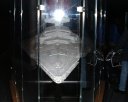 |
Frontal view of the Avenger, sighting along the vertical-longitudinal plane, from a position elevated well above the to pof the bridge tower. |
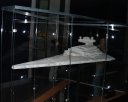 |
An overall view of the Avenger, from off the port side and above the mid-plane. This image gives a good impression of the overall layout of the dorsal terraces. |
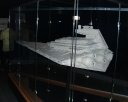 |
Oblique view of the port side of the Avenger, from behind the port wing. |
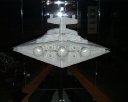 |
Comprehensive rear view of the Avenger, viewed from slightly above the mid-plane. The laminae protruding from the rear surfaces of the terraces appear to be horitzontal. (However other photographs show that the laminae on the sides of the terraces run parallel to the hull, sloping downwards towards the bow.) |
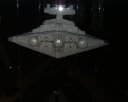 |
Another almost-direct view of the stern. There is a glimpse of detail and perhaps a vertical wall at the deep end of the shaft that leads horizontally into the tower neck. |
| stern and thrusters | |
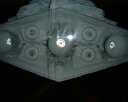 |
A direct view into the central primary thruster, sighing almost exactly along the long axis of the ship. The image is unfocessed, but is valuable for its perfect orientation. |
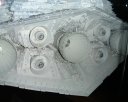 |
A clear view of the central regions of the thruster cavity, viewed from off the port side. |
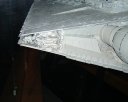 |
Detailed view of the aft end of the portside wing. The laminae and mechanisms filling this corner of the brim trench are as complex as anywhere else on the ship. There is one noteworthy structure with a row of four holes: perhaps it is similar to the holed structures found elsewhere, e.g. the tip of the bow. A tall mushroom-like structure stands out on the dorsal hull, it resembles similarly raised mechanisms or weapons that are planted forward of the terraces. |
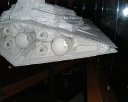 |
The stern and the starboard wing, seen from behind and to the starboard side. |
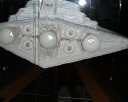 |
The central region of the thruster cavity, and the aft surfaces of the terraces, seen from slightly to starboard. The shaft into the tower neck appears to contain a long, diagonal structure rising from the floor. It doesn't seem obvious in other images; is this a trick of the shadows? |
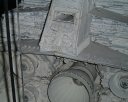 |
A detailed view of the structures on the lower back of the tower neck. The insides of the chute (from which the Avenger infamously dumped its garbage before jumping to hyperspace) are visible in detail. From this view we can exclude the possibility of any large side-shaft branching off the port wall or floor within the first few tens of metres of the aperture. |
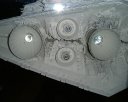 |
A detailed view of the primary and secondary engines of the port side, their mounting blocks and the complex machinery associated with them. On the larger thruster bells, we can see through some of the gaps between the edge of the bell and the electromagnetic thrust-vectoring ring (attached by relatively thin support struts). |
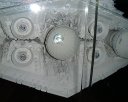 |
Detailed view of the central parts of the thruster cavity, including the secondary thrusters of the starboard side. This image complements the photo facing further to portside, as it reveals several asymmetries between the corresponding details of the port and starboard sides. |
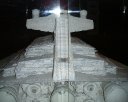 |
Direct view onto the back of the command tower, the terraces and the upper part of the thruster cavity. Details of particular interest include: a deep view of the floor of the shaft in the back of the tower neck; and a small dish structure pointing aft from the very peak of the thruster cavity. |
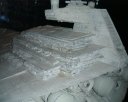 |
View of the thrusters from above and to the port side. The port side of the terraces and the bridge tower also appear in detail. |
| brim details | |
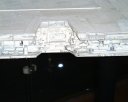 |
Detailed view of one of the minor brim notches. Windows are visible in the brim, indicating areas that are at least occasionally crewed, however there is no turret weapon that is as large or obvious as the ones in the minor notches of the Devastator. Perhaps one of the minor structures, such as the long, recessed horizontal slit, conceals a launcher for torpedoes or other such weapons. If there is a special weapon in the notch then we might infer that the notches are generally intended to give firing clearance in the otherwise sheltered brim. Otherwise the purpose of brim notches must be related to a more subtle function: perhaps something such as shield distribution. Having seen the model with his own eyes, A. Gehrls recalls that there is a dark grey object shaped vaguely like a computer mouse, at the lower rear corner of the notch, and this structure apparently had two gun barrels. The possible turret is visible in this image, at the lower right corner of the notch, but the barrels aren't clear. |
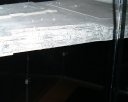 |
A detailed view of the major brim notch on the port side. The surface substructures are a texture mainly like those found in the minor notch. However there are a variety of thin vertical struts connecting some of the flat chips that sprout from the hull at different levels. Viewing across the dorsal hull at this angle clarifies the height of the rectangular panels and other features on that surface. Some interesting little nodules are much higher than the common panels; perhaps they house the medium and minor guns? Or perhaps they are minor sensory devices? |
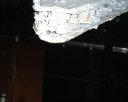 |
A close view of the bow. A four-holed structure on the lower tip is repeated above, to the left and right. What functions do these holes perform, or what devices do they conceal? |
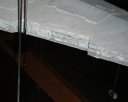 |
A wide view of the major brim notch on the starboard side. Some vertical struts are apparent, like in the portside major notch. It is interesting to note the distribution of holes on the sides of the major dorsal panel at the top of the picture. There are two rows, implying that this structure is as thick as two crewed decks. However the rows are not in the horizontal plane; rather they follow the surface of the panel. This implies that the decks and artificial gravity in this region may be inclined at a few degrees to the conventional alignment. |
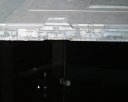 |
The minor notch in the starboard brim is modelled in less detail than the equivalent notch on the port side. An intriguing two-holed structure is apparent. |
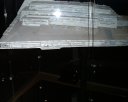 |
The brim trench on the starboard side, between the wingtip and the minor notch. |
| main turbolasers | |
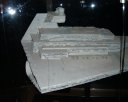 |
Wide view of the starboard side of the ship, centred on the terraces. The main turbolaser turrests are the row of four rounded but complicatedly detailed units in a longitudinal row on the hull near the base of the lowest terrace. |
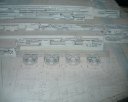 |
Detailed view of the heavy turbolaser turrets on the starboard side. Each of four rotating disks mounts eight barrels. The barrels appear to be able to elevate independently through about ninety degrees; it seems likely that the base may traverse through a full 360 degrees. It also is interesting to consider the identity of the small rectangular lumps distributed across the surface of the hull; some of them may house the smaller point-defence cannons. Are these model structures unresolved on the model, being approximations of more complex features in the "real" ship, or does their apparent lack of sub-structure hint at the small size of the point-defence guns? It is conceivable that the guns may be man-sized aparatus protruding from their rectangular emplacements through slats that are barely visible at this scale. Or, perhaps there sre retractable covers, which are all closed in the model as seen here? |
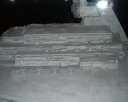 |
Wide view of the port side of the terraces, showing the portside heavy turbolasers. Their numbers and structures are equivalent to the weapons on the starboard side. In total the ship has 64 gun barrels in this class. |
| terraces and tower | |
 |
Medium-close view of the front of the bridge tower and the rear areas of the upper terraces. The rear two starboard turrets are visible at the bottom-left of the frame. |
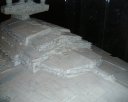 |
The upper and starboard sides of the front end of the terrace area. The bridge tower, a minor brim notch and the frontmost starboard turrets are visible in the background and left side. |
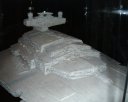 |
A more distant view of the dorsal parts of the Avenger, concentrating on the starboard side of the terraces, the starboard heavy turrets, and the bridge tower. |
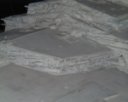 |
Port side of the lowest, forward terraces. |
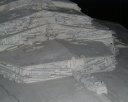 |
Deatil of the front surfaces of the terraces and the dorsal ridge of the hull. Note that the windows (and presumably the decks) are aligned with the horizontal plane of the ship (the plane of the brim trench). There is a variety of complex functional structures at various corners on the ridge, but they do not appear to have gunports or protruding cannons like the equivalent structures on the Devastator. One of the nodules on the starboard side of the front terrace is interestingly tall, suggesting that it may be a weapon. Perhaps other, lower nodules of similar area are the same kind of structure, but raised or recessed to different extents. |
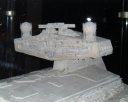 |
The closest view of the front face of the bridge tower and the top surface of the uppermost terrace. The main bridge is in a shaded gap just below the thick, nose-like lump in the centre of the tower face, but above the prominent, vertically striped structure. |
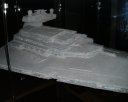 |
A wide view of the starboard upper surfaces of Avenger, showing the entire length of the terraces and the four starboard heavy turrets. |
This page was constructed and is maintained by
Curtis Saxton.
This page is neither affiliated with nor endorsed by Lucasfilm Ltd.
Original photographs from the BMoA exhibition,
within and linked from this page, are © copyright Larry Yee 2002.
This site is kindly hosted by TheForce.net.